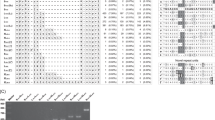Abstract
The dopamine D4 receptor gene (DRD4) has an expressed polymorphism in the third exon that may have functional relevance. The polymorphism exists at two levels. At the higher level there is an imperfect tandem repeat of 48 base pairs (bp) coding for 16 amino acids; alleles have been identified with 2 (32 amino acids) to 10 (160 amino acids) repeats. The imperfect nature of the repeats is responsible for a more subtle level of variation since alleles with the same number of repeats can differ in the exact sequences or in the order of the variants of the 48-bp unit. We have undertaken a global survey of this expressed polymorphism as one approach to understanding the evolutionary significance and origins of the polymorphism as well as understanding what selective forces, if any, may be operating at this locus. As the first step, we have determined the repeat number genotype of the DRD4 repeat polymorphism in 1,327 individuals from 36 different populations. The allele frequencies differ considerably among the different populations. The 4-repeat allele was the most prevalent (global mean allele frequency = 64.3%) and appeared in every population with a frequency ranging from 0.16 to 0.96. The 7-repeat allele was the second most common (global mean = 20.6%), appearing quite frequently in the Americas (mean frequency = 48.3%) but only occasionally in East and South Asia (mean frequency = 1.9%). The 2-repeat allele was the third most common (global mean frequency = 8.2%) and was quite frequent in East and South Asia (mean frequency = 18.1%) while uncommon in the Americas (mean frequency = 2.9%) and Africa (mean frequency = 1.7%). The universality of the polymorphism with only three common repeat-number alleles (4, 7, and 2) indicates that the polymorphism is ancient and arose before the global dispersion of modern humans. The diversity of actual allele frequencies for this expressed polymorphism among different populations emphasizes the importance of population considerations in the design and interpretation of any association studies carried out with this polymorphism.
Similar content being viewed by others
Author information
Authors and Affiliations
Additional information
Received: 18 July 1995 / Revised: 18 December 1995
Rights and permissions
About this article
Cite this article
Chang, FM., Kidd, J., Livak, K. et al. The world-wide distribution of allele frequencies at the human dopamine D4 receptor locus. Hum Genet 98, 91–101 (1996). https://doi.org/10.1007/s004390050166
Issue Date:
DOI: https://doi.org/10.1007/s004390050166




